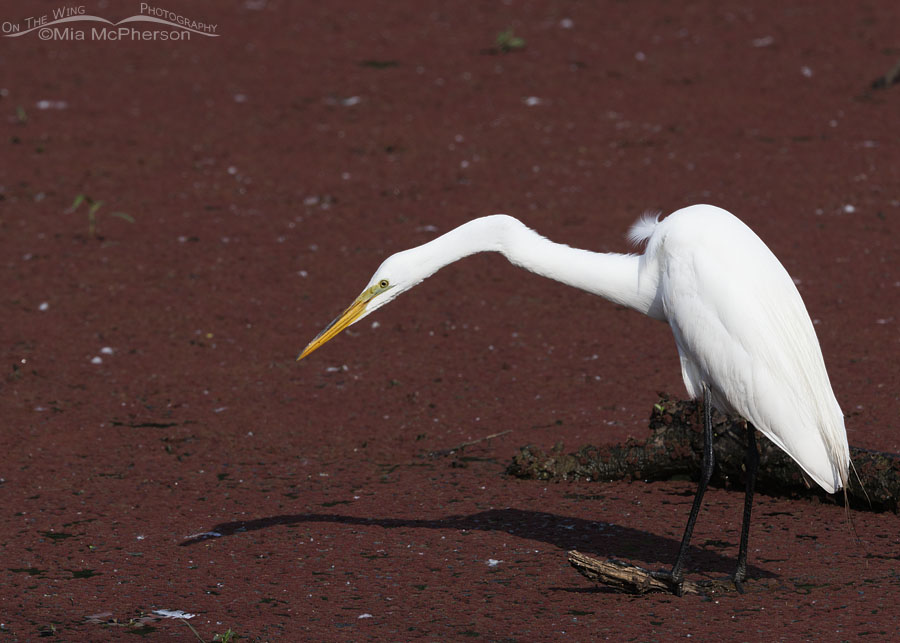When I visited my friend Steve Creek, I photographed this Great Egret at Sequoyah National Wildlife Refuge. The red vegetation floating on the water is azolla.
 Great Egret at Sequoyah NWR – Canon R7, f7.1, 1/1600, ISO 400, -1.0 EV, Canon RF 100-500 mm at 363mm, natural light
Great Egret at Sequoyah NWR – Canon R7, f7.1, 1/1600, ISO 400, -1.0 EV, Canon RF 100-500 mm at 363mm, natural light
What is Azolla?
When I researched this plant this is what I found:
Azolla is a native aquatic fern found in still or slow-moving water bodies. It is a small branching plant with a main stem and pinnate side branches. The side branches are longer at the base of the stem than at the top, giving the fronds a roughly triangular shape. Each frond is composed of many overlapping rounded leaves which are covered in tiny hairs on their upper surface.
Azolla appears green or red depending on exposure to the sun. In shaded conditions, the leaves are usually green, while in direct sunlight, they become reddish.
Azolla is also called mosquito fern, duckweed fern, fairy moss, and water fern. Azolla is known for its ability to reduce mosquito breeding populations by more than 95%. It does this by covering the surface of sluggish, still or stagnant freshwater bodies, preventing adult mosquitoes from laying eggs and also reducing the emergence and development of mosquito larvae.
Back to the Great Egret…
I liked the contrast between the red azolla and the egret’s snow-white plumage, the pose of the bird, and the shadow it cast on the azolla.
There were several birds on the same body of water that morning at the refuge, but this Great Egret stood out the most. It was my first day at the refuge, and I was mesmerized by everything I saw and heard. I’m grateful that Steve shared the refuge with me and taught me so much about it.
Thanks Steve!
Life is good.
Mia
Click here to see more photos that I have taken at Sequoyah National Wildlife Refuge. Click here to see more of my Great Egret photos plus facts and information about this species.


Spectacular shot! The balance of light and dark you captured in the pic is wonderful. Thanks Mia.
A plant that inhibits the ‘squito population? Bring it on.
Amazing contrast too.
I have not heard of or seen the plant , I will have to look up a close up to see the ferny leaves. I am glad you had a good friend to help during a stressful time by getting you out into nature and loaning his camera to you! The photos you are sharing are wonderful. Things I would love to see one day but I will enjoy yours for now.
It’s that wayward feather on the egret that makes it for me. Also, thank you for sharing the information about Azolla. We could definitely use some around here — the mosquitos are terrible this summer!
Also, thank you for sharing the information about Azolla. We could definitely use some around here — the mosquitos are terrible this summer!
Strikingly beautiful image and interesting information about Azolla (a new word for me).